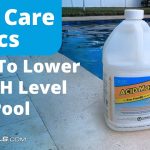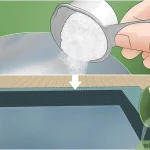To lower alkalinity in the pool, you can use chemicals such as muriatic acid or sodium bisulfate.
Testing Alkalinity Levels
Testing the alkalinity levels of your pool water is an essential step in maintaining a balanced and safe swimming environment. Properly balanced alkalinity helps to prevent pH fluctuations, ensuring the water remains clear and comfortable for swimmers. Let’s explore the different methods for testing alkalinity levels.
Using Test Strips
Test strips are widely used for quick and convenient testing of alkalinity levels. Here’s how to use them:
- Collect a water sample from elbow-depth below the pool surface.
- Immerse the test strip into the water for a few seconds, then remove it.
- Compare the color change on the strip with the provided color chart to determine the alkalinity level.
- Record the reading and take necessary actions to adjust the alkalinity if needed.
Water Testing Kits
Water testing kits provide a more precise and comprehensive assessment of alkalinity levels. These kits often include test tubes, reagents, and detailed instructions for accurate testing. Follow these steps to use a water testing kit:
- Fill a test tube with the water sample up to the marked line.
- Add the provided reagent according to the kit’s instructions.
- Observe the color change in the test tube and match it with the corresponding alkalinity level indicator.
- Take note of the reading and follow the recommended dosage of alkalinity-adjusting chemicals based on the test results.

Credit: waterguru.com
Causes Of High Alkalinity
High alkalinity in a pool can result from several factors, including chemical imbalance and the presence of minerals. Understanding the causes of high alkalinity is essential for effectively lowering it in your pool.
Chemical Imbalance
A chemical imbalance in the pool water, particularly a high level of alkaline substances such as bicarbonates and carbonates, can lead to elevated alkalinity levels. This imbalance often occurs due to the addition of excessive chemicals, poor circulation, or improper pH levels. Without proper maintenance, the alkalinity can quickly rise, causing various issues such as cloudiness and scale formation.
Presence Of Minerals
High alkalinity can also be attributed to the presence of minerals in the water, including calcium, magnesium, and other alkaline substances. These minerals can enter the pool through source water, chemicals, or environmental factors. Over time, they can contribute to a buildup of alkalinity, necessitating proactive measures to lower it and maintain a balanced pool environment.
Effective Methods For Lowering Alkalinity
Lowering alkaline levels in your pool can be achieved through methods such as using muriatic acid, adding vinegar, or using a pH reducer. These effective techniques help maintain proper balance for optimal pool water quality.
Using Muriatic Acid
Muriatic acid is a potent solution that can effectively lower alkalinity in your pool.
To use it safely, ensure you follow the manufacturer’s instructions and wear protective gear.
Carefully measure the amount needed based on your pool’s size and current alkalinity levels.
Slowly add the muriatic acid to the pool water while the pump is running to distribute it evenly.
Regularly test the alkalinity levels to monitor the progress and make adjustments accordingly.
Adding Ph Decreaser
pH decreaser is another effective solution for reducing alkalinity in your pool.
Start by testing the alkalinity and pH levels to determine the appropriate amount of pH decreaser needed.
Follow the manufacturer’s instructions when adding the pH decreaser to the pool water.
Allow the water to circulate for a few hours to ensure the pH decreaser is fully mixed.
Continue to monitor the alkalinity levels and adjust as necessary to maintain a balanced pool environment.

Credit: m.youtube.com
Balancing Ph Levels
When it comes to maintaining a clean and healthy swimming pool, balancing pH levels is crucial. The pH level refers to the acidity or alkalinity of the water, and it plays a significant role in the overall water quality.
Importance Of Ph In Pool Water
The importance of maintaining the right pH level in your pool cannot be emphasized enough. An unbalanced pH can lead to a host of problems, such as skin and eye irritations, corrosion of pool equipment, and inefficient functioning of sanitizers. Additionally, it can also affect the efficiency of other pool chemicals, making them less effective in keeping the water clean and safe.
Relation Between Ph And Alkalinity
The pH level and alkalinity of the pool water are closely related and have a direct impact on each other. Alkalinity refers to the ability of the water to resist changes in pH levels. In other words, it acts as a buffer to stabilize the pH level. When the alkalinity levels are too high, it can cause the pH to rise, making the water more alkaline. On the other hand, if the alkalinity levels are too low, it can result in a decrease in pH, making the water more acidic.
To maintain the ideal pH level, it is essential to first balance the alkalinity. Once the alkalinity is within the recommended range, it becomes easier to adjust the pH level to the desired value.
Preventive Measures
Preventive measures are crucial in maintaining a well-balanced pool environment. By taking proactive steps to lower alkalinity, you can ensure that your pool remains safe and comfortable for swimmers. Below are some key strategies to help in preventing high alkalinity in your pool.
Regular Testing And Maintenance
Regularly testing the pool water is essential to ensure that alkalinity levels remain within the recommended range. Use a reliable test kit or pH meter to measure the alkalinity levels at least once a week. This will allow you to identify any fluctuations and take appropriate action promptly. Additionally, performing routine maintenance such as skimming, vacuuming, and cleaning the pool filters can help prevent the buildup of contaminants that can contribute to high alkalinity.
Proper Chemical Usage
When adding chemicals to your pool, it’s important to follow the manufacturer’s instructions carefully. Use the correct amounts of chemicals and avoid over-treating the water. This will help maintain the proper alkalinity and pH levels, preventing the need for drastic measures later on. Additionally, storing chemicals properly in a cool, dry area can prevent contamination and ensure their effectiveness when needed.
Seeking Professional Help
When Diy Methods Fail
When DIY methods fail to lower the alkalinity in your pool, it may be time to consider seeking professional help. Persistent high alkalinity levels can lead to various pool problems, such as cloudy water, scale formation, and difficulty in maintaining proper pH balance. If your attempts to lower the alkalinity using home remedies or store-bought chemicals have not yielded the desired results, it’s imperative to consult with experts to prevent further issues.
Consulting Pool Experts
Consulting pool experts is crucial if you are struggling with reducing the alkalinity in your pool. Professional pool technicians have the knowledge, experience, and specialized equipment to accurately assess the alkalinity levels and recommend appropriate solutions. Whether it’s through on-site consultation or seeking advice from a reputable pool service company, their expertise can save you time, effort, and potential frustration. By entrusting the task to professionals, you can gain valuable insights into the best practices for maintaining balanced alkalinity, ensuring a safe and enjoyable swimming environment for you and your family.

Credit: waterguru.com
Conclusion
Incorporating these pool maintenance tips can help effectively lower alkalinity levels, ensuring a balanced pool. Regular testing and proper adjustments are key to preventing pH issues and keeping your pool clean and safe for swimming. Take control of your pool’s alkalinity for a hassle-free swimming experience all summer long.





